![]()
Insert a Bill of Materials table from an Onshape BOM table, uploaded file, or an authorized app. You are also able to use the Balloon tool to automatically pull identifiers from the BOM to label the drawing. See Balloon for more information.
Steps
-
Click
 .
.
- Select to insert a Bill of Materials from the currently active document, or another document.
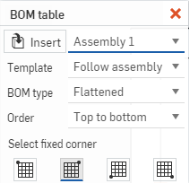
If there are Onshape BOM tables in your document, they are automatically listed in the drop down menu (shown with Master assembly above); select one, then the parameters:
- If you are part of a company or enterprise and your administrator has added BOM table templates, you can select one from the Template dropdown.
- The BOM type: Flattened (no assembly hierarchy indicated), Structured - Top level (assembly hierarchy indicated for one level only), or Structured - Multi-level (all levels of assembly hierarchy indicated).
- Order: Top to Bottom or Bottom to Top
The three types of BOMs are shown below: Flattened, Structured-Top level, and Structured-Multi-level, respectively:


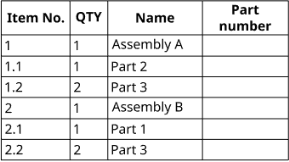
In the multi-level BOM, immediately above, the sub-assembly (Assembly A) is listed as item number 1 and it consists of two parts, listed as item numbers 1.1 and 1.2 (Parts 2 and 3). Sub-assembly (Assembly B) is listed as item number 2 and it consists of two parts, listed as item numbers 2.1 and 2.2 (Parts 1 and 3). The top-level BOM, the middle BOM above, lists only the top-level of the two sub-assemblies. The flattened BOM, the first BOM above, lists just the parts contained in the Assembly.
Structured BOM Item numbering is supported when the Drawing view's reference is different from the BOM table reference, provided the BOM table reference is contained in the view reference or vice versa.
Use the Insert icon
 to select a BOM file or table from an approved app.
to select a BOM file or table from an approved app.
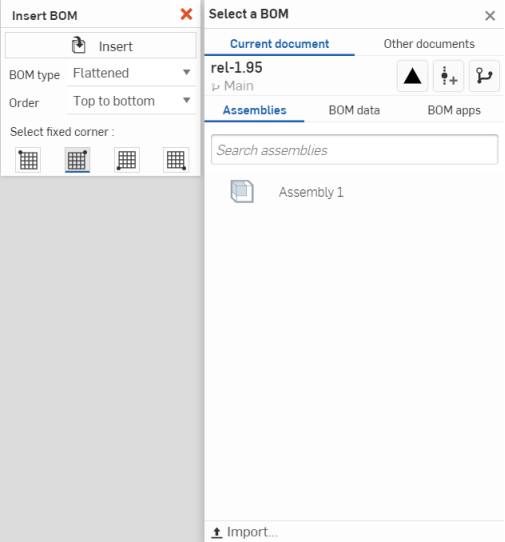
From here you can use the standard Insert dialog to select from the current document, another document, create a version to work with or select another version of a document. You can insert BOMs from versions, workspaces, and releases that don't have a BOM, as well. You can also select from Assemblies in the current document, use BOM data that you have uploaded in the form of a file, or select a BOM from an approved app you are using.
- Select whether to insert Bill of Materials data from:
- The current document or Other documents
- Assemblies - Within whatever filter you have selected: Current document or another document. The setting of the Assembly property, Subassembly BOM behavior, controls how the assembly appears in the drawing bill of material.
- BOM data - An uploaded file containing data, select the file or use the Import option at the bottom of the dialog to upload a file (not shown above) .
- BOM app - Data created from a BOM app through the Onshape App store, select the Bill of Material.
- The current document or Other documents
-
If a document contains released parts, the Release filter is present; use this filter
 to display only data that has been released.
to display only data that has been released.
- Select which corner of the table to set as your fixed corner at the bottom of the dialog (as shown below).

- Click in the drawing space to place the Bill of Material table.
The default anchor point in Onshape is the upper right corner of tables.
There is no need to click directly on the point once it is visible. While moving the mouse to place the Bill of Materials, you'll notice thin, dashed lines as the cursor passes near other entities. These are inferencing lines that you are able to align the BOM to; simply click when you see the line appear to align the BOM to that line.
When hovering your mouse over a table row entry, the following is highlighted in the drawing:
-
Callouts for the hovered entry (in blue)
-
Geometry in all views corresponding to the hovered entry
An inserted Bill of Materials is able to be edited much like any table in drawings. Click the edge of the table to select the entire table; you may grab one of the middle grab points to move the table. Right-click with the entire table selected to access these commands:
- BOM table properties - To open the properties panel for Bills of Materials
- Split BOM table below - To split the BOM table below the row the cursor was in when you right-clicked for the context menu. This splits the table into two tables. You can then select one of the tables, right-click for the context menu and use Move to sheet to move that table to another sheet in the drawing.
- Copy - To place a copy of the table on the clipboard
- Move to - (Border frame, Border zones, Title block, Drawing)
- Bring to front - Bring the selected table to the forefront of the display
- Send to back - Send the selected table to the background of the display
- Switch to <appropriate tab> - To open the tab containing the Bill of Materials data
- Move to sheet
- To move a table (or a split table) to another, existing, sheet of the drawing. You can open the Sheets panel to view the location of the BOM table and also drag/drop it to another sheet if you wish:
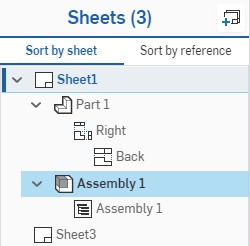
Right-click on the BOM in the list to access the context menu, including Properties, Switch to BOM (opens the Assembly tab in which the BOM originated), and Delete:
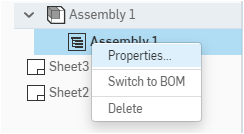
- Clear selection - Unselect the currently selected table
- Zoom to fit - Zoom the drawing to fit in the window
- Delete - Delete the currently selected table
Once the table is inserted you are able to:
- Use Shift+click to select more than one cell.
- To select a row, click the first cell and Shift+click the last cell in the row.
- To select a column, click the first cell and Shift+click the last cell in the column.
- Click and drag a corner to resize the table.
Formatting the table
-
You are able to right-click in the table and select Size and choose from resizing Columns equally and resizing Row equally. Click and drag a horizontal or vertical midpoint to resize the table.
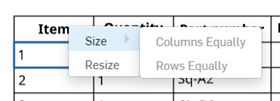
-
To resize the rows and columns on both sides of the cell edge, without resizing the table, hover your cursor over the top or right cell edge, and when the cursor changes to a double-sided arrow, click and drag the line and drop it in the new location. To resize only the row or column of the selected cell, and have the rest of the table resize, hover your cursor over the bottom or left cell edge, and when the cursor changes to a double-sided arrow, click and drag the line and drop it in the new location.
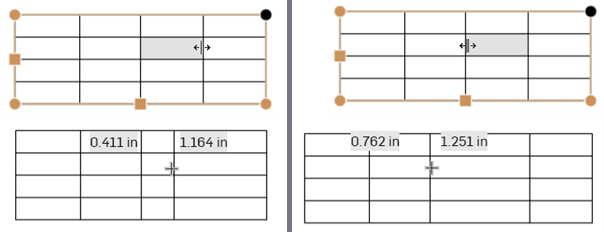
Resizing both columns on either side of the dividing edge, without resizing the table (left two images), and resizing only the selected cell's column and having the rest of the table resize accordingly (right two images).
-
To resize the column width or row height numerically, select a cell, right-click and select Resize to open the Resize dialog. Enter the new Column width and Row height measurements.
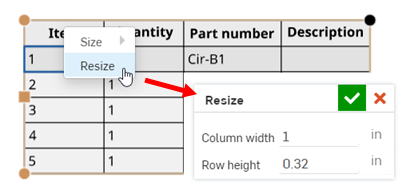
- You can click on the mid-points of a table to automatically size to fit the contents of the table.
- Single-click in a table cell or row to activate the Cell formatting panel:
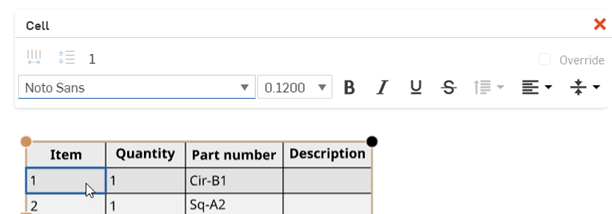
Cell formatting panel
Double-click in a table cell to open the cell formatting panel:

-
 Size columns equally
- Resize all selected columns to the average width
Size columns equally
- Resize all selected columns to the average width
-
 Size rows equally
- Resize all selected rows to the average height
Size rows equally
- Resize all selected rows to the average height
You can access these commands from the context menu when at least one cell is selected:

-
Override - Select this checkbox to override the content of the selected cell, and enter a new value in the cell formatting panel. Press Enter to accept the edit, and then press
 to close the dialog. When the content of a cell is overridden, a black triangle indicator is displayed at the bottom left corner of the cell, and a tooltip indicates the cell is overridden when hovering your mouse over the cell:
to close the dialog. When the content of a cell is overridden, a black triangle indicator is displayed at the bottom left corner of the cell, and a tooltip indicates the cell is overridden when hovering your mouse over the cell:

-
A BOM line item must have a Part Number assigned before you can override its properties in the table. If the contents of a cell cannot be overridden, the Override checkbox and label are grayed out.
-
If multiple cells are selected, the content of the cells and the Override checkbox are not displayed.
-
All other text formatting commands are the same as those found in the Note panel.
Copy table cells from Onshape drawing tables, and paste them into Excel, Google Sheets, or an Onshape drawing as a new, editable table.
Copying an Onshape drawing table into Excel or Google Sheets is supported on Google Chrome, Mozilla Firefox, and Microsoft Edge. Safari is not supported. Copying text may yield different results due to platform limitations.
-
Open an Onshape drawing table.
-
Click and drag to select the cells to be copied. The selection is shown with a yellow outline.
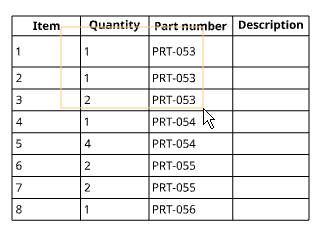
-
Release the selection. The selected cells are outlined in blue. Press ctrl+c, or right-click and select Copy.
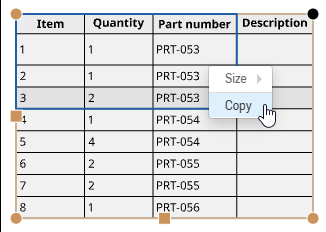
-
Open the drawing or external sheet into which you want to paste the content.
-
Right-click the location you want to paste the table and select Paste (or press ctrl+v).
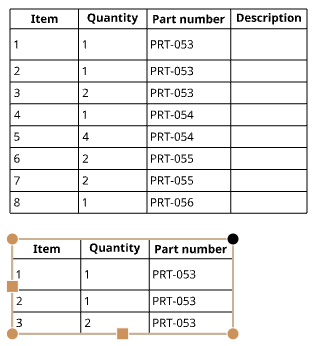
If using Onshape in a Mozilla Firefox browser, use ctrl+v to paste the table. Using the Paste command from the context menu is not supported.
Right-click the edge of the table and select Delete. You can also delete a BOM table from the Sheets panel: right-click the BOM in the Sheets panel, and select Delete.
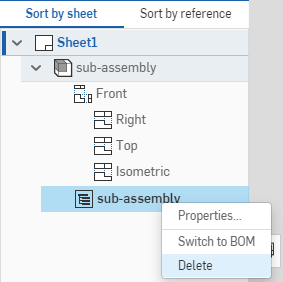
Once a BOM table is placed in a drawing, you can replace it with another BOM table if you wish:
- Open the Sheets panel and locate the listing for the BOM table you wish to replace:
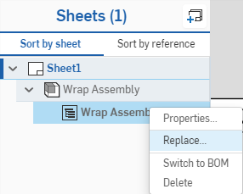
- Right-click on the listing and select Replace.
- In the Insert dialog that appears, select the Assembly whose BOM you wish to insert:
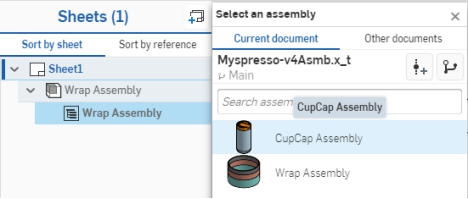
- The BOM is replaced with the BOM of the selected Assembly.
- The views associated with the BOM are also replaced to reference the selected Assembly.
Select the table, then right-click and select BOM table properties to open the Properties dialog for that table:
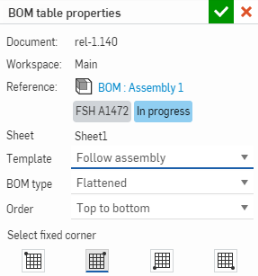
Click the Reference link to open the tab containing the original BOM data.
Select:
- BOM type - For Onshape BOMs:
- Flattened (no assembly hierarchy shown)
- Structured (assembly hierarchy shown)
- Order:
- Top to bottom - (Default) Header at top of table and rows in the order in which they appear in the BOM app.
- Bottom to top - Header at bottom of table and rows in reverse order as they appear in the BOM app.
You can select a BOM template (if your administrator has enabled and supplied templates) from the Template dropdown.
To adjust which corner of the table is your fixed corner, click your preferred option at the bottom of the BOM table properties dialog:
